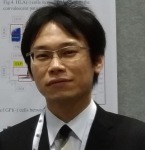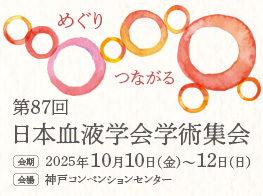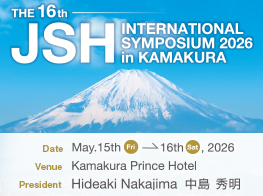
名前:辻 紀章【金沢大学医薬保健研究域医学系 血液内科学】
発表形式:Oral Presentation
Title:
Glycosylphosphatidylinositol-anchored protein deficiency confers resistance to antigen-specific T cells on hematopoietic stem progenitor cells in aplastic anemia patients with HLA-DR15
Authors:
Noriaki Tsuji1, Kohei Hosokawa1, Ryota Urushihara1, Mikoto Tanabe1, Hiroyuki Takamatsu1, Ken Ishiyama1, Hirohito Yamazaki2, Shinji Nakao1
Affiliations:
1. Department of Hematology, Kanazawa University, Kanazawa, Japan
2. Division of Transfusion Medicine, Kanazawa University Hospital, Kanazawa, Japan
Abstract:
Background: Glycosylphosphatidylinositol-anchored protein-deficient (GPI[-]) cells are often detected in patients with acquired aplastic anemia (AA) and are thought to represent immune pathogenesis of bone marrow (BM) failure; however, little is known what kind of immune responses favor the proliferation of PIGA-mutated hematopoietic stem progenitor cells (HSPCs) over GPI(+) HSPCs to induce an increase in GPI(-) cells in peripheral blood (PB) of AA patients. We recently identified HLA-DR lacking HSPCs in four AA patients with HLA-DR15 whose hematopoietic function depended on cyclosporine (CsA, ASH2020 abstract #933). Since DR15 has been implicated in the development of PNH and all these patients possessed GPI(-) granulocytes, CD4+ T-cell attack that allows DR15(-) HSPCs to survive may also contribute to the survival advantage of GPI(-) HSPCs.
Aims: To test this hypothesis, we analyzed the HLA-DR expression on GPI(+) and GPI(-) HSPCs in PB of patients with AA or PNH in remission, and determined which HSPC population underwent the HLA-DR loss.
Methods: We determined the HLA-DR expression on HSPCs defined as lineage-CD45dimCD34+CD38+ cells in 52 AA patients (38 with GPI[-] granulocytes and 14 without) and 5 with hemolytic PNH (37 with DR15 and 20 without DR15) as well as 20 healthy individuals using flow cytometry with anti-pan-HLA-DR antibodies. All patients were in remission after immunosuppressive therapy or anabolic steroids, although 20 required low-dose CsA to maintain remission. Nineteen (33%) had HLA-class I allele-lacking (HLA-class I[-]) leukocytes due to 6pLOH and/or allelic mutations.
Results: Eight (14.0%, 6 with AA and 2 with PNH) of the 57 patients had DR(-) cell populations accounting for 11.1% to 56.0% (median 39.8%) of HSPCs, and these cells were not detected among either monocytes or B lymphocytes of the same patients or among HSPCs of any healthy individuals. All 8 of these patients possessed either HLA-DRB1*15:01 (n=5), DRB1*15:02 (n=2), or DRB1*15:01/15:02 (n=1), with the other DRB1 alleles differing among individuals. In addition to HSPCs completely lacking DR, these patients also possessed HSPCs partially lacking DR, findings that were not detected in the other 49 patients or healthy individuals. Of particular interest, DR(-) cells were exclusively detected in GPI(+) HSPCs in four patients (two with AA and two with PNH) whose HSPCs were able to be analyzed separately for GPI(+) and GPI(-) HSPCs. In one patient whose HSPCs were serially evaluable over 6 years, the DR(-) cell proportion increased from 29.2% to 57.1% following temporary discontinuation of CsA, during which period the proportion of GPI(-) granulocytes in PB increased from 0.037% to 3.78%. Only 1 of the 8 patients possessed HLA-class I(-) leukocytes, which were detected in 19 (39%) of 49 patients not possessing DR(-) HSPCs.
Summary/Conclusion: HLA-DR-lacking HSPCs were exclusively detected in AA/PNH patients with DR15, suggesting that CD4+ T cells specific to autoantigens presented by DR15 are involved in the development of BM failure. The presence of HSPCs partially lacking DR in these patients suggests the presence of HSPCs that lack DR15 but retain the other DR allele. Given that DR(-) cells were only detected in GPI(+) HSPCs and the expansion of DR(-) cells occurred concomitantly with the expansion of GPI(-) clones after CsA cessation, the antigen-specific CD4+ T-cell attack against HSPCs is likely responsible for the survival advantage of GPI(-) HSPCs in AA/PNH.
The EHA2021 受賞レポート
この度はEHA2021への参加にあたり、JSH Abstract Achievement Award for The EHA2021に採択していただき、誠にありがとうございました。
今回、EHA Congressには初めての参加となりました。今年のEHA Congressは、新型コロナウイルス感染症の世界的な流行の影響を受けて、昨年と同様にバーチャルでの開催となりました。現地開催の大きなメリットとしては、世界中の研究者たちと直接ディスカッションできることだと思いますが、今回は直に会って自由に話をすることができなかったのが残念でした。一方で、オンデマンド配信では、重要なポイントを聞き逃してしまった時や即座に理解できなかった時も、何度も視聴できることがメリットだと感じました。また、通常の学会では同時刻のプログラムは一つしか参加することができませんが、オンライン学会であれば別のプログラムも視聴できます。普段はなかなか参加することができない講演も視聴することができ、意義深い学会となりました。YoungEHA Research Meetingにも招待していただき、自分の専門分野の一つである正常造血・幹細胞に関する基礎的な話題を幅広く学ぶことができましたので、今後の研究に役立てたいと思います。また、近年盛んになっている免疫細胞療法に関する最新の話題も興味深いものばかりで、臨床医としても心躍る学会でした。
本学会で私は、再生不良性貧血(AA)患者の造血幹前駆細胞(HSPC)において、HLAクラスIIの欠失が認められることを世界で初めて報告しました。近年、急性骨髄性白血病における造血幹細胞移植後の再発例において、芽球のHLAクラスII発現が低下し、GVL効果を回避していることが相次いで報告されています。AAでは、一部の症例でHLAクラスI欠失がみられることが報告されていますが、HLAクラスII欠失の報告はありません。一方で、AAや発作性夜間ヘモグロビン尿症(PNH)、低リスク骨髄異形成症候群では、HLA-DR15の有無が免疫病態と深く関わっていることが報告されていますが、詳細なメカニズムは未だにわかっていません。今回、多数のAA患者のHSPCを解析することで、DR15陽性患者でのみエピジェネティックにHLAクラスII欠失が生じていることを明らかにしました。この現象は、DR15が提示する自己抗原特異的なCD4陽性T細胞からの免疫逃避を反映していると考えられました。また、AAでは、GPIアンカー膜蛋白欠失血球、いわゆるPNH型血球がしばしば検出されますが、どのような機序でPNH型幹細胞が生存優位性を獲得するのかは長年よく分かっていませんでした。DR15欠失は非PNH形質の野生型HSPCでのみ起こっていること、免疫抑制療法の漸減に伴いDR15欠失細胞と共にPNH型クローンサイズも拡大するといった事実から、PNH型幹細胞に関する病態についても新たな知見が得られました。
今回、自分の研究を口演発表として発表できる機会をいただけたのは、大変ありがたい事でした。事前に録画した発表自体はオンデマンド配信され、後日Live Q&A sessionとして、ライブ配信の形でディスカッションの場が設けられました。質問者の名前と顔が見えない中で、パソコン越しで聞き取りづらい英語に四苦八苦しながらの回答となりました。一方で、鋭い質問を通して、自分の研究に着目してもらう喜び、他の研究者の着眼点を知ることができ、今後の研究生活に役立つ、刺激的で有意義な時間となりました。
最後になりますが、このような素晴らしい賞に採択していただき、日本血液学会賞等選考委員会、国際委員会の先生方、事務局の皆様に、心より御礼申し上げます。また、日頃より御指導いただいております、中尾眞二先生、細川晃平先生をはじめ、研究に協力してくださった先生方、研究に快く同意・協力していただいた患者の皆様に感謝申し上げます。



